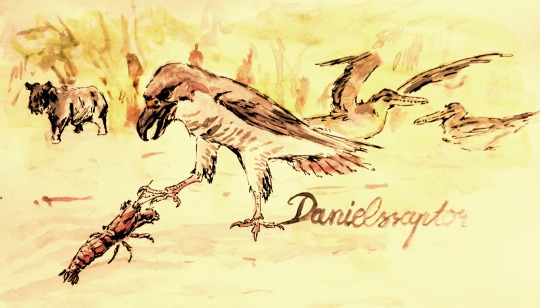#danielsraptor
Text

The evolution of falcons is rather poorly understood. Thanks to genetic evidence we know that they're closely related to seriemas, parrots, and passerines, but their fossil record is patchy and little is known about the early members of their lineage.
But a group knows as masillaraptorids are giving us a rare glimpse at what some early falconiforms were up to. Known from the Eocene of Europe, these long-legged predatory birds seem to have been caracara-like terrestrial hunters specializing in chasing down prey on foot – although their wings and tails indicate they were also still strong fliers.
Danielsraptor phorusrhacoides lived during the early Eocene, about 55 million years ago, in what is now eastern England. Although only known from partial remains, it was probably around 45-60cm long (~1'6"-2'), and it had a large hooked beak with a surprising amount of convergent similarity to those of the flightless South American terror birds.
Its mixture of falcon-like and seriema-like features may indicate that the common ancestor of both of these bird groups was a similar sort of leggy ground-hunting predator.
———
NixIllustration.com | Tumblr | Twitter | Patreon
#science illustration#paleontology#paleoart#palaeoblr#danielsraptor#masillaraptoridae#falconiformes#australaves#bird#dinosaur#art
762 notes
·
View notes
Text

ITS TIME
FOR
DINOSAUR MARCH MADNESS 2k23!!!!!!!!!!!!
Starting NEXT WEEK, we begin the ultimate competition:
DMM: RISING STARS
These are ALL dinosaurs that have been discovered in the past five years!!! New friends from old times!!! Including such new fan favorites as Bajadasaurus, Jakapil, Meraxes, and Anachronornis - and that's only four of them!
From the weird to the wonderful, these dinosaurs are here to indicate that just because they were found recently, doesn't mean that they aren't destined to become icons like the names we already know and love. Get ready to learn about some new paleontological excitement - and debate angrily over which ones are better ;)
Round One will go from March 1st through the 7th
Round Two will extend from March 8th through the 14th
Round Three will then go from the 15th to the 21st
Round Four from the 22nd to the 28th
And the FINAL FOUR SHOWDOWN (Ornithischian Vs Sauropodomorph vs Nonavian theropod vs Bird) will occur from March 29th through April 4th!
Thanks to the new tumblr poll feature, reconstructions and mini factfiles for each dinosaur will be on the post with the poll itself! No need to leave tumblr, no personal research, no google quizzes - just rapid learning and immediate voting!
Get ready to vote! Get ready to debate! Get ready... for DINOSAUR MARCH MADNESS!
Round One Matchups under the readmore :)
SAUROPODOMORPHA (and miscellany)
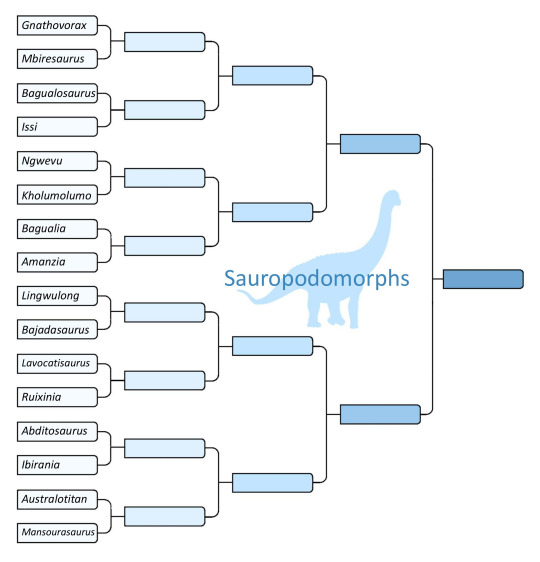
Gnathovorax vs Mbiresaurus
Bagualosaurus vs Issi
Ngwevu vs Kholumolumo
Bagualia vs Amanzia
Lingwulong vs Bajadasaurus
Lavocatisaurus vs Ruixinia
Abditosaurus vs Ibirania
Australotitan vs Mansourasaurus
ORNITHISCHIA
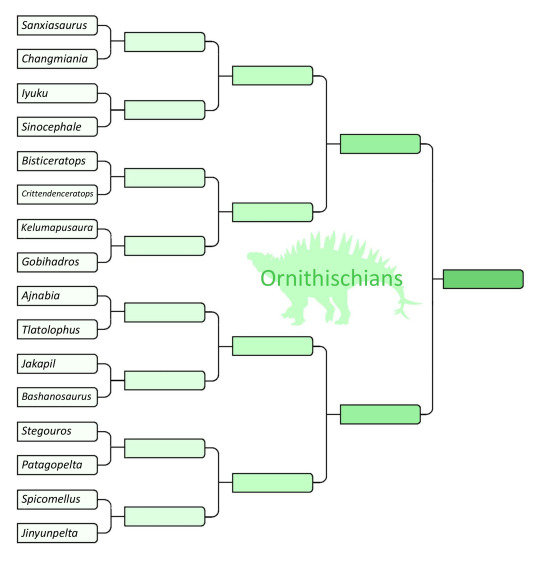
Sanxiasaurus vs Changmiania
Iyuku vs Sinocephale
Bisticeratops vs Crittendenceratops
Kelumapusaura vs Gobihadros
Ajnabia vs Tlatolophus
Jakapil vs Bashanosaurus
Stegouros vs Patagopelta
Spicomellus vs Jinyunpelta
NONAVIAN THEROPODA
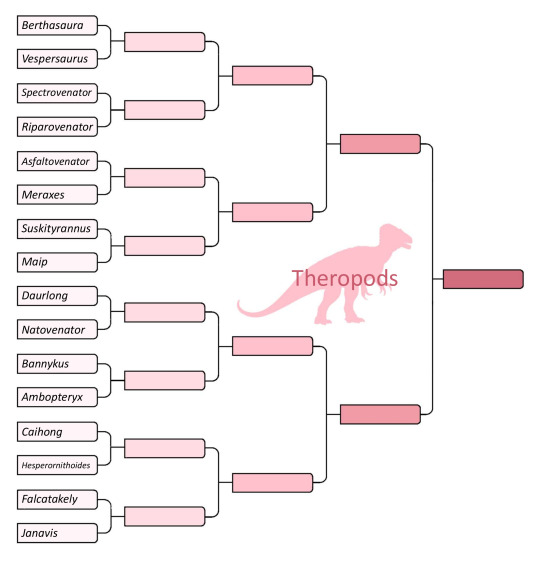
Berthasaura vs Vespersaurus
Spectrovenator vs Riparovenator
Asfaltovenator vs Meraxes
Suskityrannus vs Maip
Daurlong vs Natovenator
Bannykus vs Ambopteryx
Caihong vs Hesperornithoides
Falcatakely vs Janavis
NEORNITHES (BIRDS)

Vorombe vs Prodontopteryx
Asteriornis vs Panraogallus
Anachronornis vs Conflicto
Annakacygna vs Nasidytes
Aviraptor vs Cryptogyps
Miosurnia vs Primoptynx
Danielsraptor vs Heracles
Eofringillirostrum vs Heliothraupis
#dinosaur march madness#dmm#dmm rising stars#palaeoblr#dinosaurs#bracket#polls#march madness#tumblr dinosaur competition#thank you tumblr for making polls dmm is so much easier now I will cry#heliothraupis#eofringillirostrum#heracles#danielsraptor#primoptynx#miosurnia#cryptogyps#aviraptor#nasidytes#annakacygna#conflicto#anachronornis#panraogallus#asteriornis#prodontopteryx#vorombe#janavis#falcatakely#hesperornithoides#caihong
835 notes
·
View notes
Text
Fossil Novembirb: Day 8 - Raptors Are Back

Once the Cenozoic had begun, the only remaining dinosaurs were modern birds. That means raptors (or dromaeosaurs) would never again stalk the Earth, right? Wrong! Raptor dinosaurs get their name from modern raptors: eagles, hawks, owls and the like; and they are in fact some of the closest relatives of birds. So during the Paleogene period when predatory birds started to radiate, they weren't reinventing being a raptor. They continued being raptors.
Palaeoglaux: An early owl from Germany's Messel Lake, about 40 million years ago. Unlike modern owls, it had strange ribbon-like feathers on its body, likely used in display.
Horusornis: A strange relative of hawks and eagles that lived in France 35 million years ago. Like modern harrier-hawks, it had flexible feet to dig out prey from tree cavities.
Antarctoboenus: An early relative of falcons found from Antarctica, about 35 million years ago. It may have prowled near the edges of giant penguin colonies.
Danielsraptor: Another early falcon from the 50 million year old London Clay formation. It had a large jagged beak and long legs, which helped it catch prey on the ground.
Dynamopterus: A relative of Seriemas and terror birds from Messel lake, about 40 million years ago. It likely caught small vertebrates from the forest floor.
Paleopsilopterus: One of the earliest known terror birds, it lived in Brazil about 50 million years ago. It was already flightless and similar to later small terror birds.
Bathornis: A distant relative of terror birds that was remarkably successful. This flightless predator and its relatives lived in North America from the Late Eocene to the Oligocene.
Messelastur: A falcon-like bird of prey that was closely related to parrots and passerines instead of raptors. It lived in Messel Lake about 40 million years ago.
Masillaraptor: A tiny true falcon also known from Messel Lake. It had a relatively long beak from a falcon, and it may have fed mostly on large insects.
Tynskya: Another small raptor related to parrots and passerines, this falcon-like predator lived around 50 million years ago. Its remains have been found in North America and Europe.
#Fossil Novembirb#Novembirb#Dinovember#birblr#palaeoblr#Birds#Dinosaurs#Cenozoic Birds#Palaeoglaux#Horusornis#Antarctoboenus#Danielsraptor#Dynamopterus#Paleopsilopterus#Bathornis#Messelastur#Masillaraptor#Tynskya
76 notes
·
View notes
Text
FOSSIL NOVEMBIRB - DAY 8
Raptors! Danielsraptor is just a block
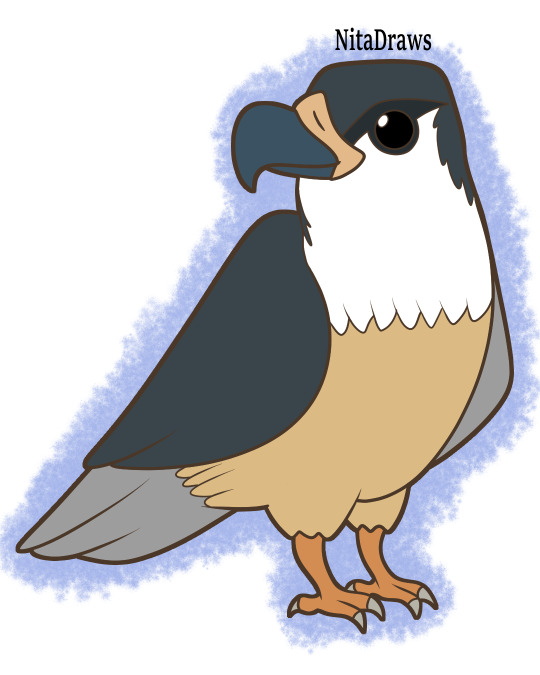
As always, you can get all these cute stuff in my redbubble
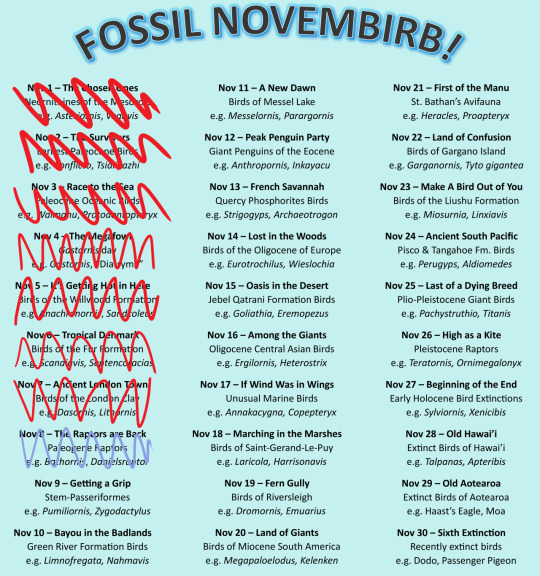
32 notes
·
View notes
Text
Danielsraptor phorusrhacoides Mayr & Kitchener, 2022 (new genus and species)

(Skull of Danielsraptor phorusrhacoides [scale bar = 10 mm], from Mayr and Kitchener, 2022)
Meaning of name: Danielsraptor = [collector of the original fossil] Michael Daniels’s thief [in Latin]; phorusrhacoides = similar to phorusrhacids
Age: Eocene (Ypresian), 54.6‒55 million years ago
Where found: London Clay Formation, Essex, U.K.
How much is known: Partial skeleton of one individual including parts of the skull and limbs. A second partial skeleton including parts of the shoulder girdle and the end of the tail may also belong to this taxon.
Notes: Danielsraptor was a bird of prey, similar to but larger than Masillaraptor from the Eocene of Germany and the U.K. Masillaraptor had been previously suspected to have been closely related to modern falcons, but because previously described fossils of this genus were mostly preserved as flattened skeletons, their anatomical details were hard to discern. The three-dimensionally preserved material of Danielsraptor reveals several additional features that link these birds to falcons, including grooves along the biting surface of the upper beak (”tgr” in the figure above) and a projection in the back of the lower jaw (”prj” in the figure above). Danielsraptor and Masillaraptor were likely strong fliers and may have also been able to hunt on the ground, though their feet appear to have been less specialized for grasping prey than those of living falcons.
Interestingly, Danielsraptor also had a few traits in common with members of Cariamiformes (a group including the modern seriemas and the extinct phorusrhacids or terror birds), with its long, deep beak being especially similar to those of phorusrhacids. Genetic studies indicate that falcons and seriemas are fairly close relatives, so the distribution of features in Danielsraptor might indicate that a mixture of “falcon-like” and “seriema-like” characteristics was present in the last common ancestor of both groups.
Reference: Mayr, G. and A.C. Kitchener. 2022. New fossils from the London Clay show that the Eocene Masillaraptoridae are stem group representatives of falcons (Aves, Falconiformes). Journal of Vertebrate Paleontology advance online publication. doi: 10.1080/02724634.2021.2083515
50 notes
·
View notes
Text
Danielsraptor vs Heracles
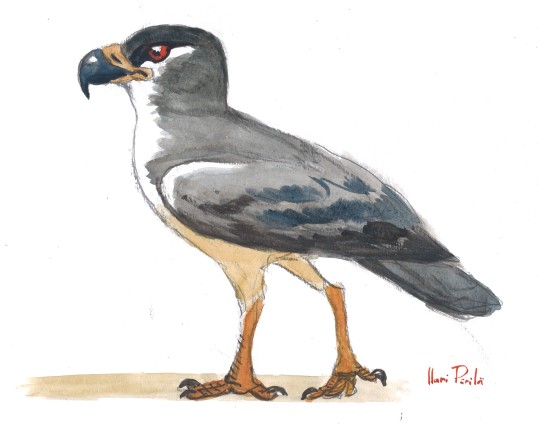

Factfiles:
Danielsraptor phorusrhacoides

Artwork by @otussketching, written by @zygodactylus
Name Meaning: Michael Daniels’ Terror Thief Bird
Time: 55 million years ago (Ypresian stage of the Eocene epoch, Paleogene period)
Location: Walton Member, London Clay Formation, England
While the Eocene fossil records of Seriemas, Passerines, and Parrots are fairly well known, the last remaining group of Australavians - the Falcons - remains something of a mystery. Danielsraptor helps to put together this puzzle a little more. Along with Masillaraptor, these birds show an early radiation of falcon-relatives from the Eocene in which they tried out a more terrestrial lifestyle! Danielsraptor had long legs, allowing it to forage and hunt on the ground like modern caracaras. It had a very large pygostyle, giving it long tail feathers - and with strong wing bones, it was able to fly in addition to hunt on the ground. It had a beak very similar to living caracaras and the extinct Terror Birds, further corroborating the idea that it was a bird of prey (and also potentially indicating a more complex evolutionary story for the early-derived Australavians). Living in the London Clay, Danielsraptor would have been one of the top predators, easily hunting the small mammals as well as the birds it shared its environment with - aided by both its terrestrial stalking abilities as well as its flying capability. Living in the London Clay, it shared its environment with the early loon Nasidytes, early owls, trogons, paleognaths, tropicbirds, duck-screamers, other diurnal raptors, the pseudotoothed bird Dasornis, and many parrot-passerine relatives. Crocodilians, snakes, turtles, fish, sharks, and a handful of mammals (including a primate) also lived in this rich post-Paleocene-Eocene Thermal Maximum environment.
Heracles inexpectatus

Artwork by @otussketching, written by @zygodactylus
Name Meaning: Unexpected Herculean Parrot
Time: 16 to 19 million years ago (Burdigalian stage of the Miocene epoch, Neogene period)
Location: St. Bathans Fauna, Bannockburn Formation, Aotearoa
Heracles was a truly alarmingly large parrot, related to modern day Kea, Kaka, and Kakapo, known from the fantastic avifauna of St Bathans. Standing more than two feet tall and weighing about fifteen pounds, this animal was much larger than any expected from the St Bathans fauna, which represented the initial colonization of Aotearoa (Zealandia) after it returned above sea level. Heracles is also the largest known species of parrot, ever. It was presumably flightless, though it is uncertain if it was nocturnal like its living relative the Kakapo. Its exact ecology is still uncertain, given the material known from Heracles is limited and its living relatives have very disparate ecologies, though it is possible it was omnivorous similar to the Kea and Kaka today. The St Bathans fauna lived in a freshwater lake system, in a subtropical emergent rainforest. Separated from land bridges, the fauna was dominated by birds, with early relatives of the Kiwi, New Zealand Wrens, Adzebills, and Wedge-Tailed eagles found in the fauna, as well as somewhat modern looking Moas. Smaller flamingos, large fruit pigeons, and a huge variety of geese and other waterfowl are known. In addition, frogs, tuataras, other lizards, crocodilians, turtles, and many different types of fish are known from this fascinating ecosystem.
DMM Round One Masterpost
#dmm#dinosaur march madness#dmm round one#dmm rising stars#palaeoblr#dinosaurs#paleontology#bracket#march madness#danielsraptor#heracles#polls
178 notes
·
View notes
Text
Fossil Novembirb 8: The Raptors Are Back
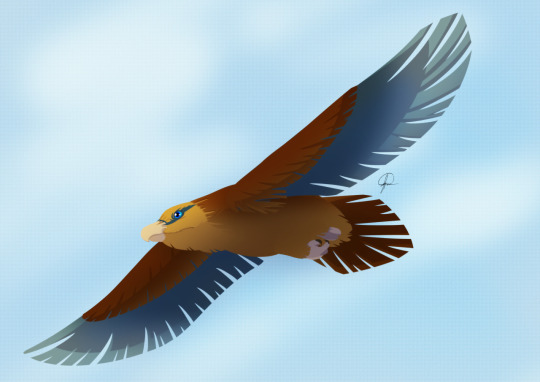
Palaeohierax by @quetzalpali-art!
Alright we're back with a look at the raptors of the Paleogene!
Raptor meaning, of course, bird of prey. Which I wouldn't have to say, except this is a dinosaur blog, and a lot of the time people in dinosaur circles use "raptor" to mean "Dromaeosaur" exclusively. Ironic, given that birds of prey used the word first!

Pulchrapollia by @drawingwithdinosaurs
We've already talked about some of the birds of prey that appeared right after the extinction, such as all the early owls, Qianshanornis, and Danielsraptor. Truth is, being a carnivore is a useful ecology, and birds - having evolved from Paravians like Dromaeosaurs - already have a lot of the tools for chowing down! So, carnivorous birds just keep re-evolving all the time - corvids are sometimes considered raptors, and they're deeply nested within Passerines! And of course, modern roadrunners are essentially mini Velociraptors, but they're cuckoos!
In fact, it seems that most birds alive today evolved from a carnivorous ancestor! All the early-branching members of Telluraves, aka "Core Land Birds" (which includes all passerines and many more besides) are raptorial - owls, hawks, eagles, kites, seriemas, even falcons. And the early ancestors of Passerines and Parrots - things like Halcyornis - were birds of prey as well!
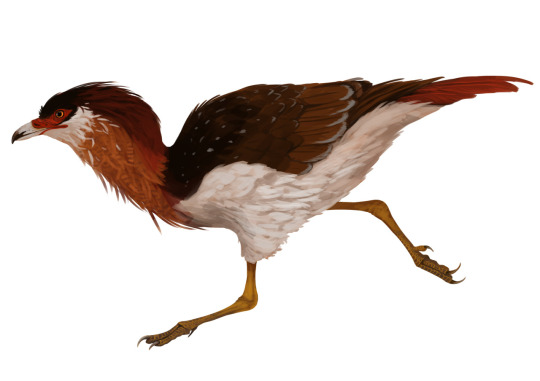
Dynamopterus by @thewoodparable
As we saw with Danielsraptor and Qianshanornis, fast running predatory birds have been a thing since the ash started clearing up from the asteroid. There are just so many small animals to eat and so little time to catch them! Relatives of falcons and seriemas continued to pursue (heh) this lifestyle, and were quite common in the Paleogene fossil record.
In fact, Seriemas - today limited to just a handful of species in South America - had a very successful time of it during the Paleogene and Neogene, with species spread all across the globe. Dynamopterus (sometimes called Idiornis) was from the later Eocene of Europe, and it lived very similarly to living seriemas in its ecosystem! Itaboravis was present in the early Eocene in South America, and we also have Bathornis in North America!
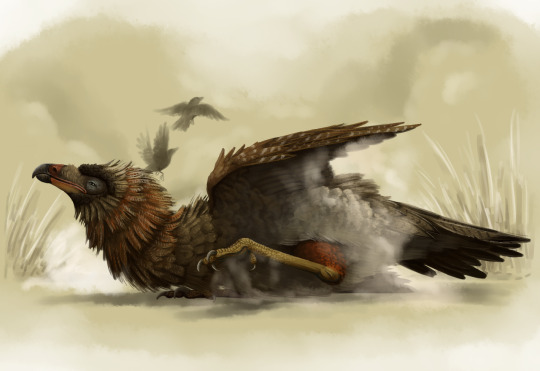
Bathornis by @drawingwithdinosaurs
Bathornis was a very terror-bird-like seriema relative that lived in North America from the Eocene through the Miocene, found in many different environments and at many sizes throughout its existence, including plains and wetlands. Flightless like its terror bird cousins, it had a strong beak to help in catching food and powerful legs for moving quickly across the landscape to catch it!

Ogygoptynx by Apokryltaros/Avancna
Of course, I cannot ignore flighted predatory birds entirely. Though modern ones don't have a lot of fossil relatives (they start appearing in the Oligocene with forms like Palaeohierax), it seems that volant raptors were simply found in other clades - many owls were diurnal, and the relatives of modern parrots and passerines were small carnivores as I mentioned above. With ridges over their eyes to help with glare, these animals could find prey over long distances and fly to them rapidly from their perches - something quite terrifying for the little mammals they ate!
From grasping talons to sickle claws to powerful beaks and eyes, these animals - though small - had major impacts on their environments. Some grew to be so large they would hunt humans - but that's a story for another article.
Sources:
Mayr, 2022. Paleogene Fossil Birds, 2nd Edition. Springer Cham.
Mayr, 2017. Avian Evolution: The Fossil Record of Birds and its Paleobiological Significance (TOPA Topics in Paleobiology). Wiley Blackwell.
88 notes
·
View notes
Text
Fossil Novembirb 7: Ancient London Town

Halcyornis by @thewoodparable
Next on our excellent tour of Early Eocene Ecosystems is the London Clay Formation - an increasingly important location near yesterday's Fur that showcases another coastal forest of the post-PETM hothouse world. Filled with tons of fossil plants, London Clay is one of the world's most diverse localities for fossil seeds and fruits. Plus, it's lousy with dinosaurs! In fact, the first ever named fossil bird, Halcyornis, is from the London Clay!
Much like the Fur, there are just too many different kinds of birds in this ecosystem for me to talk about all of them - and more and more are being named lately, thanks to the donation of the late Michael Daniels' collection to researchers at last. There were strange ducks and owls, parrot-passerines of prey, paleognaths and loons, pseudotoothed birds and raptors, swifts and tubenoses and tropicbirds and more! Heck, even fossil cuckoo-rollers were present!

Nasidytes by @otussketching
In fact, the wide spread of many birds that today are limited to places in the southern hemisphere, such as Cuckoo-Rollers and Trogons, is a fascinating look into the radiation of Neoaves around the time of the PETM. Currently, the best hypothesis for this change is that these birds were adapted to the tropical temperatures, and when those climate bands retreated to their present positions these birds followed them. A prediction for the results of anthropogenic climate change? Who knows.
What's extra fascinating is that clearly, some birds didn't move, but just adapted to the cold - such as loons like Nasidytes above, as well as a variety of fowl and other birds. Why some birds went one way, and others another - and still others, towards extinction - remains a mystery.
But back in the Eocene, they were all hanging out together, apparently all over the place! That's what flight will get you, of course.

Dasornis by @quetzalpali-art
London Clay has a surprising amount of Pseudotoothed birds, which had been around since the Paleocene but did not become common until the Eocene. But here there were two different species - Dasornis and Odontopteryx - that were already well on their way to exploiting the marine soaring bird niche that most Pelagorns would one day inhabit.
Raptors were diversifying wildly here, too, with early relatives of falcons like Danielsraptor present and trying out a more terrestrial lifestyle than living falcons - perhaps an ancestral ecology for Australaves, given that Seriemas diverged before them! With a large curved beak and long legs, it was able to prowl the environment and hunt the scores of other birds living around it!
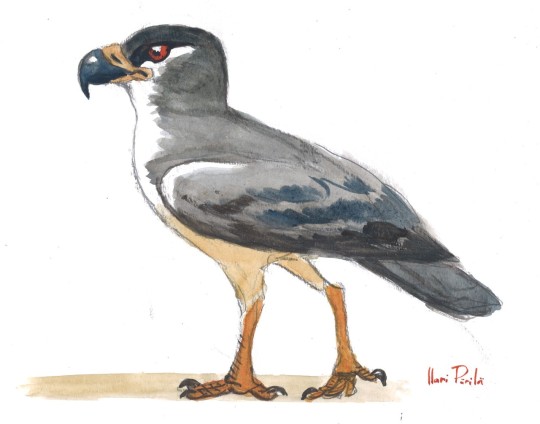
Danielsraptor by @otussketching
Lithornis was here, too, as it has been in the last two - a real staple of the PETM world, this Palaeognath was a strong flier, and was probably able to expand its territory successfully as the climate warmed around the world. The lack of Palaeognaths in North America and Europe today now seems even weirder by comparison! These birds would have used their long beaks to probe the sand and dirt for all the different sources of food hiding inside.
Early storm-petrels also showed up, alongside more tropicbirds, in the form of Primodroma and Prophaeton respectively, indicating that these kinds of shore birds not only evolved multiple times, but lived alongside each other in more of the world than they do today. Parrot-Passerines of prey, like Halcyornis and Pulchrapollia and Tynskya, were everywhere and filling the niche of tree dwelling raptors instead of things like falcons and hawks - amazing how much these dinosaurs have changed since!

Anatalavis by @quetzalpali-art
I would be remiss if I didn't bring up the ducks I helped to describe! Danielsavis was another hodgepodge duck-screamer, though less of it was preserved than Anachronornis. That said, it had a more screamer-like foot, shoulder, and jaw. With it lived Anatalavis, a bird possibly related to the living Magpie-Geese of Australia - wading birds with not much webbing and long goose-like necks. Anatalavis had a very duck-like beak, making it a filter-feeder, rather than a macrofeeder like the living Magpie-Goose. Eating on smaller animals and plants in the water, it didn't have any modern-type ducks around for competition!
Early owls were here too, like Ypresiglaux, a very small owl - weighing possibly less than 50 grams! This means that Ypresiglaux was the smallest known Owl of all history, and probably ate mostly arthropods. It also couldn't turn it's head around as much as living owls, and was possibly diurnal! Birds just kept diversifying into so many niches, it's amazing to see both the similarities and differences across so many clades.
Sources:
Collinson, M. 1983. Fossil plants of the London Clay. The Palaeontological Association 1: 1-122.
Mayr, 2022. Paleogene Fossil Birds, 2nd Edition. Springer Cham.
Mayr, 2017. Avian Evolution: The Fossil Record of Birds and its Paleobiological Significance (TOPA Topics in Paleobiology). Wiley Blackwell.
52 notes
·
View notes
Text
Annakacygna vs Nasidytes
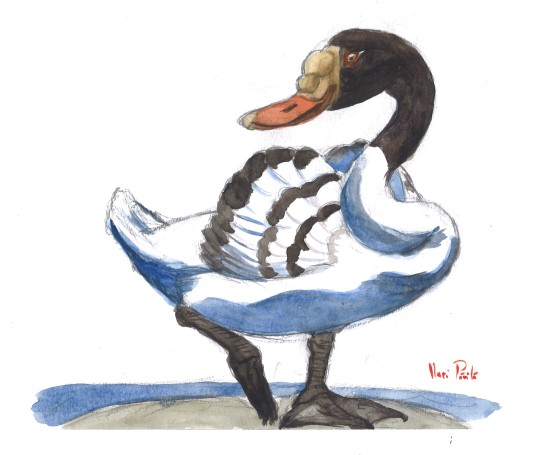

Factfiles:
Annakacygna hajimei, A. yoshiiensis

Artwork by @otussketching, written by @zygodactylus
Name Meaning: Swan from Annaka (Hajime’s or of Yoshii-machi)
Time: 11.5 million years ago (Tortonian stage of the Miocene epoch, Neogene period)
Location: Haraichi Formation, Annaka, Japan
Annakacygna was dubbed during its research “the ultimate bird”, and honestly, I don’t even blame the scientists for doing so - I may have even done the same. Both large species of swan, A. hajimei was about the size of a black swan, and A. yoshiiensis was larger than even the mute swan. They were weird in so many ways it boggles the mind: they were adapted for filter feeding in the water, their wings and tails were so flexible they could form a cradle for their young on their backs like modern mute swangs, said tails and wings were probably great and flashy display structures, its head was extremely large weird looking and had a slightly spoon-like bill, they had wide and heavy vertebrae but still had long and flexible necks, it may have even been a flightless bird or at least a poor flier based on its sternum and coracoids, though its scapula is extremely strong and unlike flightless animals - more research is needed to better understand this aspect of its mobility. That said, it did have very short wing birds, weirdly curved and short among birds, with weirdly shaped finger bones coming together to create weirdly formed curved wings. Its hips were arched up, creating a dip in its back, and it had narrow leg bones, allowing for efficient movement in the water like living *grebes and loons*. So while it had this whole weird display structure with its wings and tail going on, and its robust but long neck, and that strangely boat-shaped body (what the actual f-), it was zooming through the water like a grebe or loon. It had a similar beak to living shovelers, possibly, and it could move its jaw back and forth in a seesaw like motion, not like any living swans. It could then filter food through its jaws via this motion, eating a variety of plankton through soft lamellae within its bill. It was probably very social, given its display structures, and communicated both vocally (imagine the power of those calls with that robust neck) and visually. Annakacygna also took care of its young, extensively, keeping them on their back protected in their wings, to the point that they may not have spent much time on land (like living loons and grebes). It wasn’t a deep diver, but was stable at sea while foraging on food and moving along the surface of the water, living primarily in the ocean. Found in a marine environment, Annakacygna lived with sharks, seals, many kinds of whales, and desmostylians.
Nasidytes ypresianus

Artwork by @otussketching, written by @zygodactylus
Name Meaning: Ypresian Diver of Naze
Time: 55 million years ago (Ypresian stage of the Eocene epoch, Paleogene period)
Location: Walton Member, London Clay Formation, England
Nasidytes is the earliest known loon known via the fossil record, similar to other early fossil loons known from later times. It had a shorter and wider beak than living loons, and it had pleurocoels like most birds but unlike modern loons. It already had the weird wing proportions found in modern loons, and it had webbed feet similar to many water birds. Nasidytes probably wasn’t an aquatic pursuit predator, like its living relatives. Instead, it probably fed on marine invertebrates, making short foot-propelled dives for food. It lived near the coast, in a vibrant habitat filled with a wide variety of other early birds emerging right after the Paleocene-Eocene Thermal Maximum. The London Clay Formation was an early tropical coastal forest, much like those found in Southeast Asia today. Some of Nasidytes’ neighbors included Danielsavis, a weird duck-screamer; diurnal raptors including the masillaraptorid Danielsraptor; early relatives of owls, trogons, paleognaths, and tropicbirds; the pseudotoothed bird Dasornis; and a wide variety of parrot-passerine relatives. Crocodilians, snakes, turtles, fish, sharks, and a few mammals also lived in this environment, including an early primate Platychoerops.
DMM Round One Masterpost
#dmm#dinosaur march madness#dmm round one#dmm rising stars#palaeoblr#dinosaurs#paleontology#bracket#march madness#annakacygna#nasidytes#polls
103 notes
·
View notes
